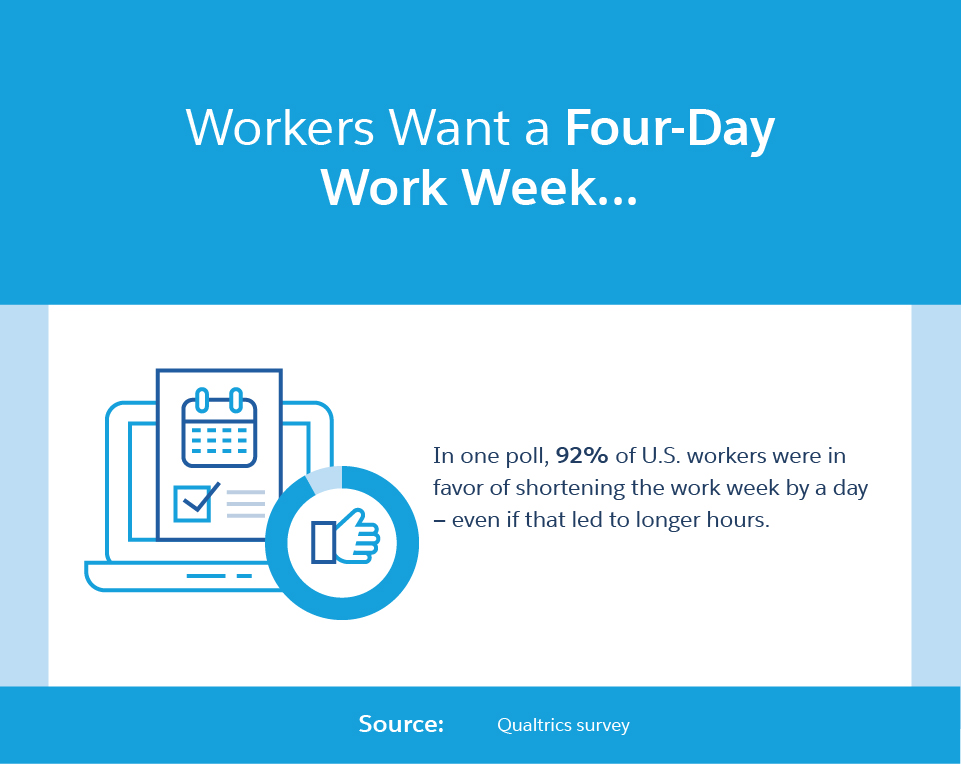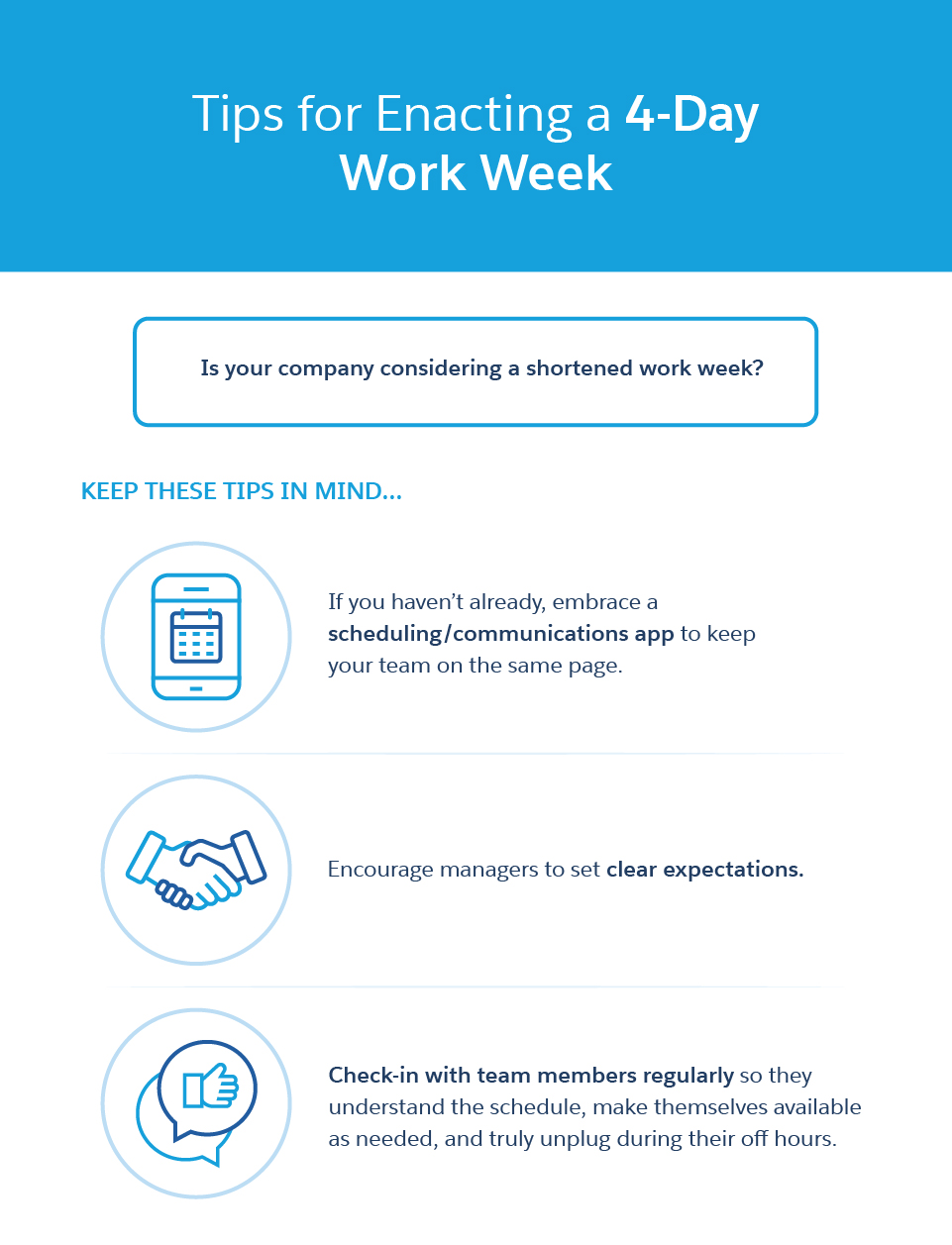Working in an office for eight hours a day, Monday through Friday, has been the standard employee experience for decades. But today, some businesses are wondering if that’s the only option.
When the pandemic shook things up in 2020, decision makers at many companies began to realize that the traditional approach to the work week was not the only possibility. Effectively, hybrid work and remote work have become far more popular in the last couple of years, initially due to health and safety concerns, but now, largely due to employee preference. In the wake of these changes, yet another alternative work schedule is gaining popularity: the four-day work week.
In North America, over 60 companies have made the shift to the four-day work week. However, that change isn’t as simple as giving employees an extra day off. Business owners who opt to rethink their requirement for time in the office (physical or virtual) must also consider what tech and tools their teams need to make this switch a success. When workers are spending less time with colleagues, it makes it even more important that they’re able to make the best use of the time they do have together.
While flexibility is important to employees, a shorter work week does not automatically translate to a better employee experience — workers must be able to accomplish the work they need to do in the time they’re given—or this amended schedule could backfire, creating a stress-ridden experience for everyone involved.

What Constitutes a 4-Day Work Week?
So, how do you interpret the four-day work week?
Some four-day businesses still expect employees to hit 40 hours per week. Others, however, prefer to shift to a 32 hour-per-week model, which is what 4 Day Week Global, a nonprofit associated with the University of Oxford, proposes.
A shortened work week relies on efficiency to remain productive, and when you factor in remote or hybrid workers, this simply can’t be accomplished unless you have the technology in place to allow teams to connect at a moment’s notice, just as they would if they were in the office together.
Benefits to the 4-Day Work Week
In a changing economic landscape, it’s more important than ever to attract and retain top talent. According to 4 Day Week Global, 63 per cent of businesses found recruitment and retention easier with a shortened work week. That makes sense, given that a report from intelligence company Morning Consult found that 43 per cent of people considering leaving their employer point to work-life balance as a top reason for departure.
That being said, numerous businesses in Canada, Australia, New Zealand, Iceland, and the U.K. have been testing out a four-day, 32-hour work week that, notably, does not reduce pay. By and large, these companies are reporting success. With fewer hours in the office, focus is sharpened and productivity is boosted. Mental health gets a boost, too, with 91 per cent of employees at New York-based social media company Buffer reporting that they’re happier and more productive with the four-day work week the company instituted a year and a half prior.
Between the rise in hybrid and remote work, as well as the increased popularity of shortened work weeks (or at least more flexible hours), many employees are seeing an increase in their overall quality of life; they can see their families more, dedicate more time to the hobbies that rejuvenate them, and generally find a better balance between work and life.
However, a shortened work week is not without its potential problems.
Potential Issues With a Shortened Week
The aforementioned Qualtrics survey that saw such enthusiasm for a four-day work week (versus a five-day work week) also found that an even more popular option among workers was to have increased flexibility when they need it. Employees aren’t simply seeking less time in the office, but rather the ability to adjust their work hours as life demands change. For example, if you’re a working parent, having every Friday off work isn’t as beneficial as having the freedom to leave work early twice a week to watch your daughter’s basketball games.
Also worth considering is the fact that, although the employees surveyed by Qualtrics were on board with less time in the office, 46 per cent believed that the shortened work week would have a negative impact on business, and 55 per cent feared that the change would frustrate consumers.
An increase in pressure may also be a concern, according to a New Zealand study. Although the study found that employees tended to favour a four-day work week, that change actually intensified what they called “entrenched managerialist practices of performance measurement, monitoring, and productivity pressures.” In other words, reducing the hours employees are expected to work without also adjusting expectations and productivity benchmarks can be a recipe for conflict and miscommunication.

Employing the Right Tools is the Key to 4-Day Work Week Success
If the true purpose of initiating a four-day work week is to reduce employee burnout — without sacrificing productivity — then efficiency is critical. And, as any manager or team leader knows, creating efficiency in your workplace means having the proper systems, tools, and resources in place.
For instance, not every office can simply close for one day a week — and even if they can, some employees may prefer to have Fridays off, while others may prefer a different day. Offering your team the flexibility to choose when and how they work is empowering, but it can also lead to challenges when it comes to scheduling meetings or connecting with coworkers as questions arise. If your sales team needs to sit down with your marketing team, you don’t want them wasting a day sending emails to nail down a time; you need to have a scheduling and communications app or platform in place to make that a simple, one-step process.
Fortunately, that’s exactly what technology like Slack (which allows teams to communicate in real time from wherever they’re working) is designed for.
Yet, even with all the right tech, it’s still up to management to set expectations around availability. Are there specific days or hours when all employees should be available for meetings? Days when no meetings should be scheduled? Even if you set this up properly in your platforms of choice, make sure all team members understand the schedule, both so they can make themselves available as needed and to truly unplug during their off hours.

Conclusion
From helping you build your dream team to increasing employee satisfaction, the four-day work week is certainly worth consideration. As long as you set it up with clear expectations — and the right tools to support it — you might just find that your team can do even more in less time. And that’s a win for everyone!


